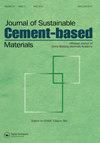Bioconcrete based on sulfate-reducing bacteria granules: cultivation, mechanical properties, and self-healing performance
IF 4.2
3区 工程技术
Q1 CONSTRUCTION & BUILDING TECHNOLOGY
Journal of Sustainable Cement-Based Materials
Pub Date : 2022-12-05
DOI:10.1080/21650373.2022.2153389
引用次数: 6
Abstract
Using waste-activated sludge as a source for non-axenic sulfate-reducing bacterial (SRB) granules, this study developed an innovative bioconcrete with 1% and 2% SRB granules. The mechanical properties (AS 1012.9 and AS 1012.21) and self-healing performance of bioconcrete was systematically examined. The 28-d compressive strength of bioconcrete samples met the design requirement of 50 MPa and the general limit of 13% for average volume of permeable voids (AVPV). Within 3–4 weeks, both 1% and 2% bioconcrete samples precipitated 300–400 µm of calcite in different water media such as glucose, calcium acetate, tap water, and real wastewater. The SEM analysis revealed that SRB granules survived mortar incorporation and precipitated calcium carbonate in the form of calcite which were further confirmed by EDS and XRD analysis. The tap water healed 1% and 2% bioconcrete samples had water permeabilities 64.2% and 69.9% lower than the control, respectively. The mass loss in 5% sulfuric acid was 3.8% and 3.2% less, respectively, for 1% and 2% bioconcrete specimens with surface calcite deposition after 120 d.硫酸盐还原菌颗粒生物混凝土:培养、力学性能和自愈性能
利用垃圾活性污泥作为非无菌硫酸盐还原细菌(SRB)颗粒的来源,本研究开发了一种具有1%和2% SRB颗粒的创新生物混凝土。系统地考察了生物混凝土的力学性能(AS 1012.9和AS 1012.21)和自愈性能。生物混凝土试样28 d抗压强度满足设计要求50 MPa,平均渗透孔洞体积(AVPV)一般限值为13%。在3-4周内,1%和2%的生物混凝土样品在不同的水介质(如葡萄糖、醋酸钙、自来水和实际废水)中沉淀300-400µm的方解石。SEM分析表明,SRB颗粒在砂浆掺入过程中幸存下来,并以方解石的形式沉淀碳酸钙,EDS和XRD分析进一步证实了这一点。经1%和2%生物混凝土处理的自来水透水率分别比对照低64.2%和69.9%。1%和2%表面方解石沉积的生物混凝土试样,在5%硫酸中处理120 d后,质量损失分别减少3.8%和3.2%。
本文章由计算机程序翻译,如有差异,请以英文原文为准。
求助全文
约1分钟内获得全文
求助全文
来源期刊
CiteScore
6.60
自引率
15.90%
发文量
71
期刊介绍:
The Journal of Sustainable Cement-Based Materials aims to publish theoretical and applied researches on materials, products and structures that incorporate cement. The journal is a forum for discussion of research on manufacture, hydration and performance of cement-based materials; novel experimental techniques; the latest analytical and modelling methods; the examination and the diagnosis of real cement and concrete structures; and the potential for improved cement-based materials. The journal welcomes original research papers, major reviews, rapid communications and selected conference papers. The Journal of Sustainable Cement-Based Materials covers a wide range of topics within its subject category, including but are not limited to: • raw materials and manufacture of cement • mixing, rheology and hydration • admixtures • structural characteristics and performance of cement-based materials • characterisation techniques and modeling • use of fibre in cement based-materials • degradation and repair of cement-based materials • novel testing techniques and applications • waste management

 求助内容:
求助内容: 应助结果提醒方式:
应助结果提醒方式:


